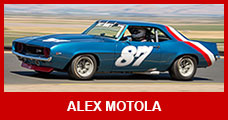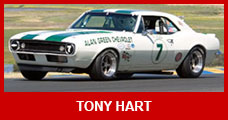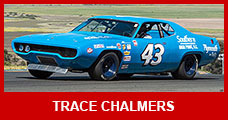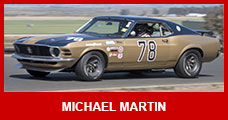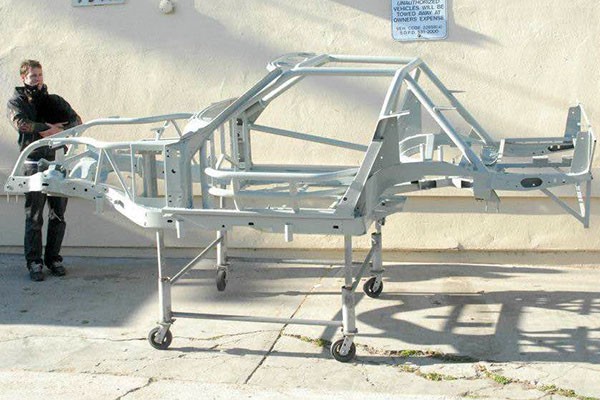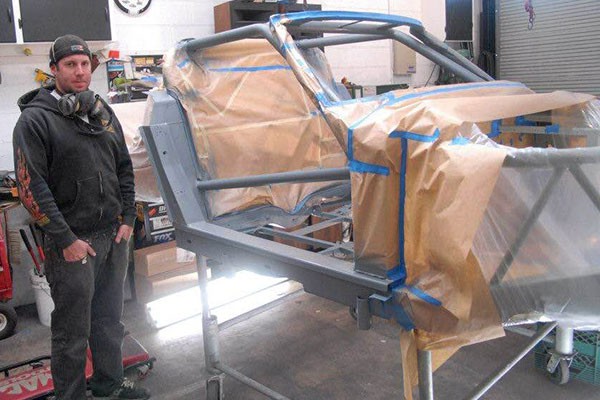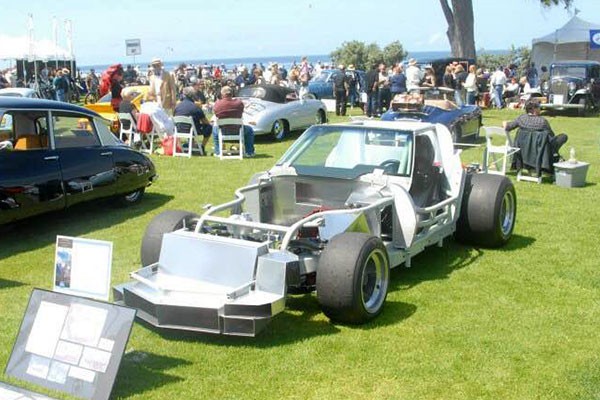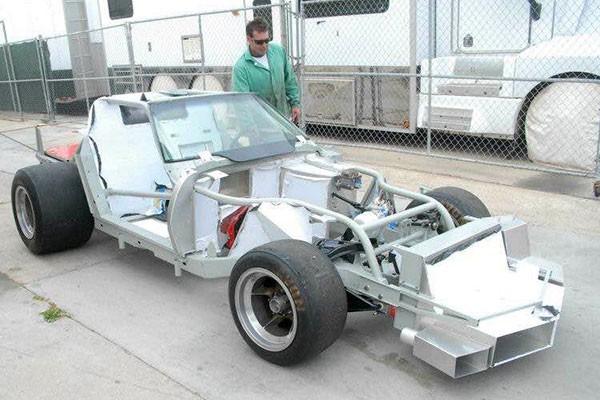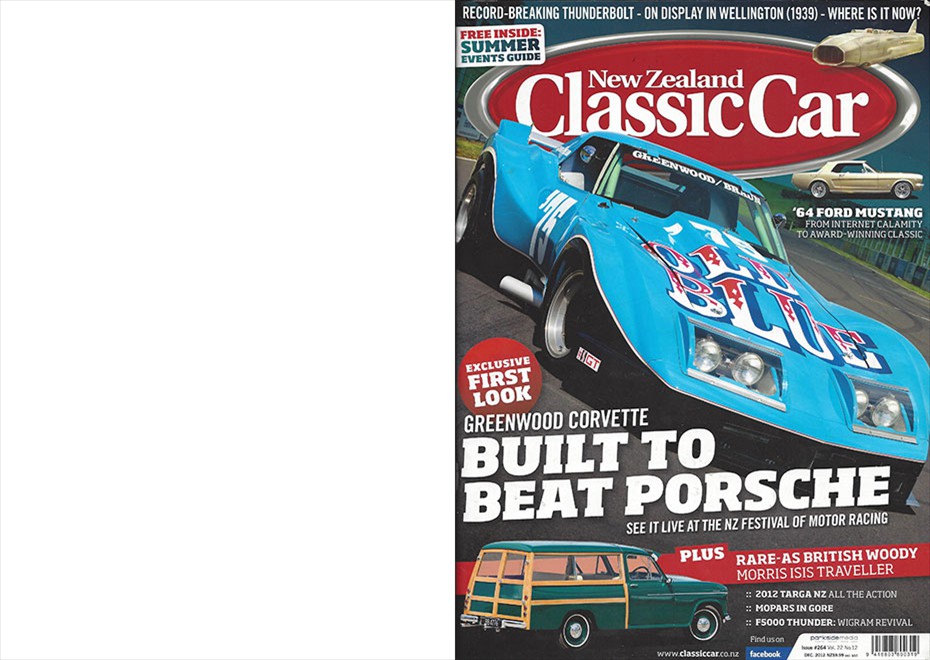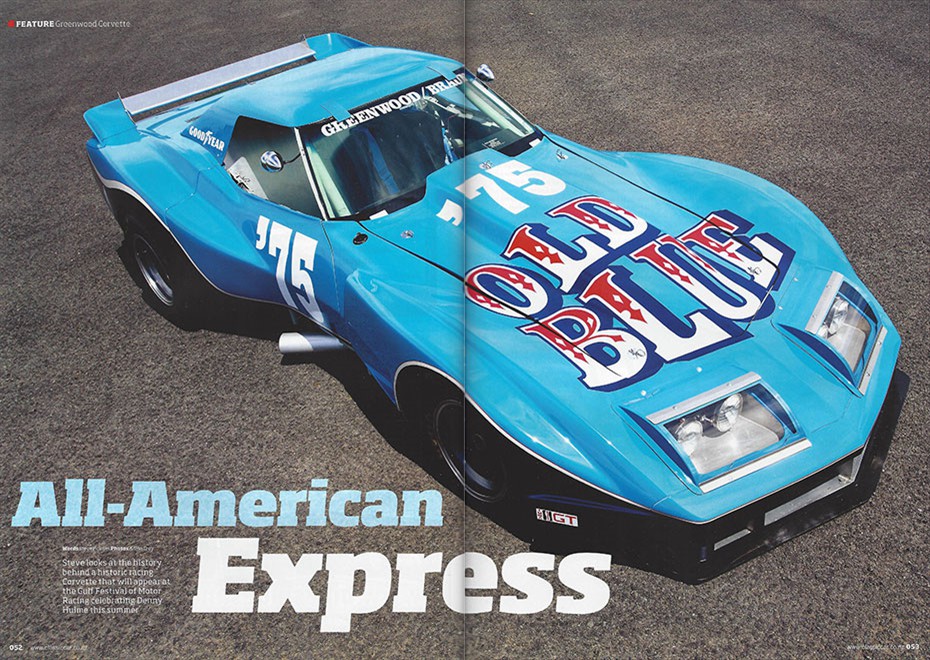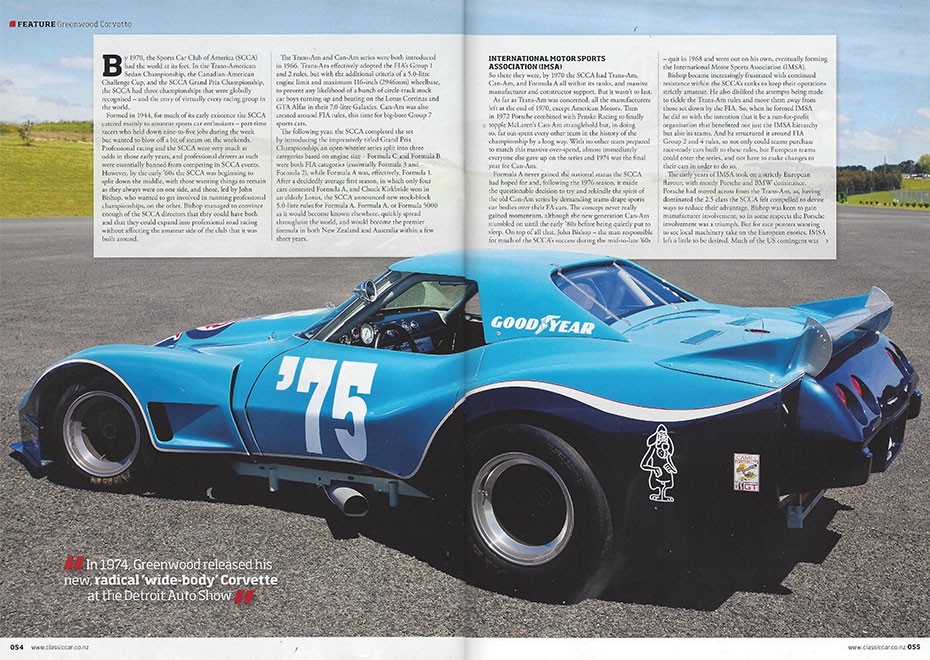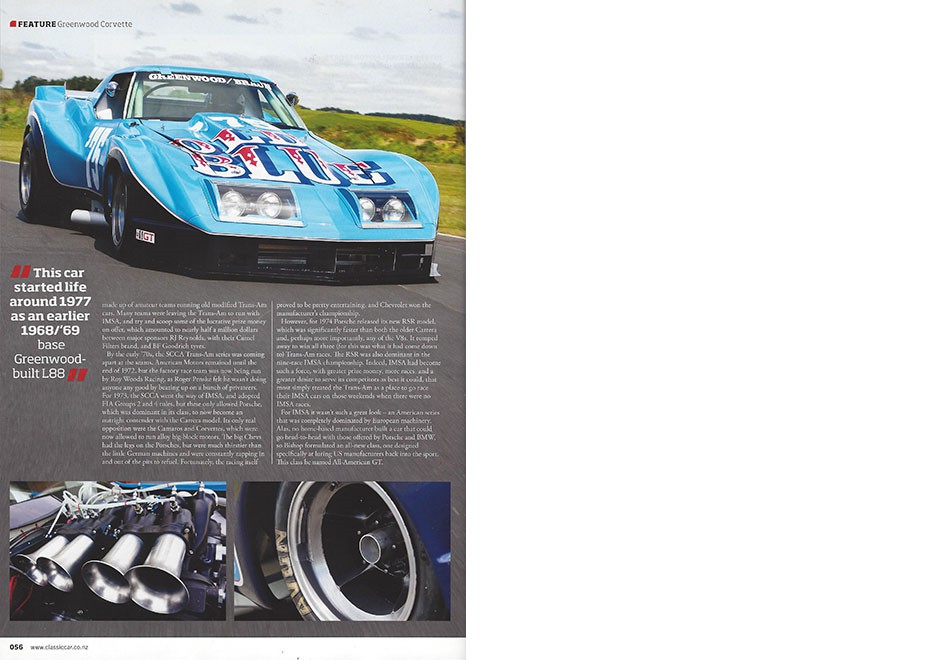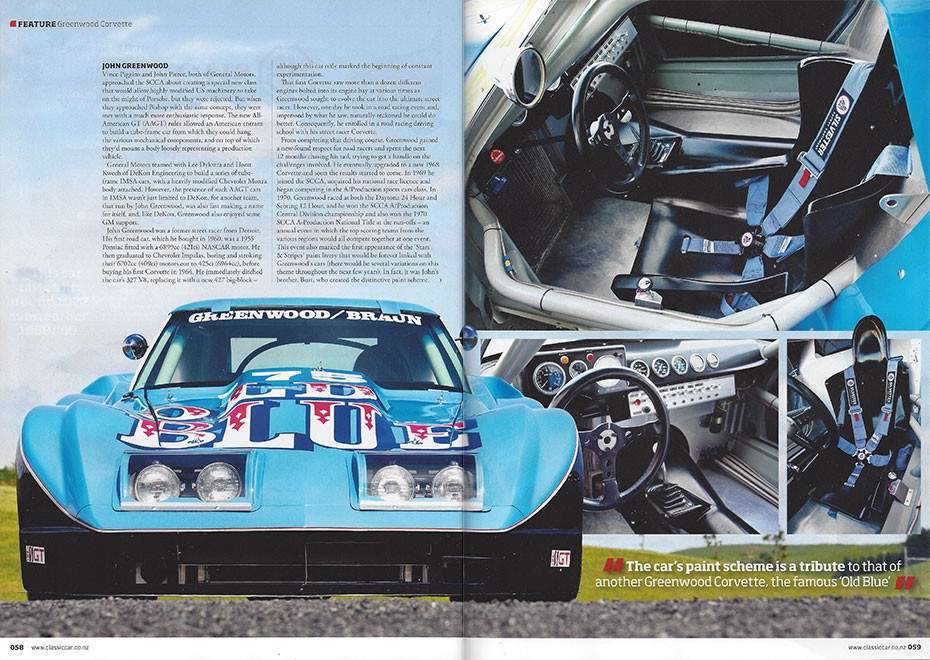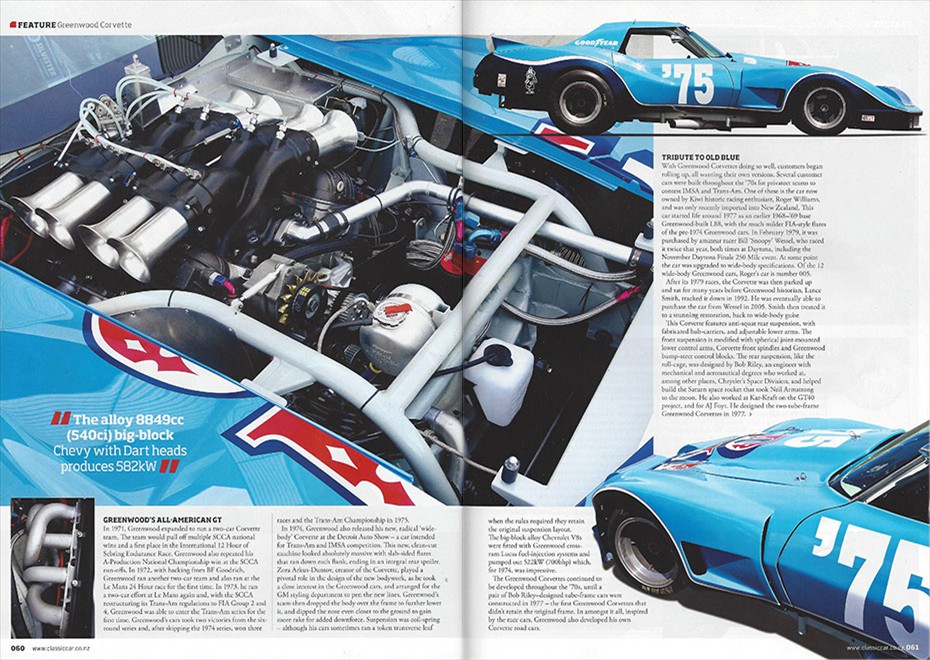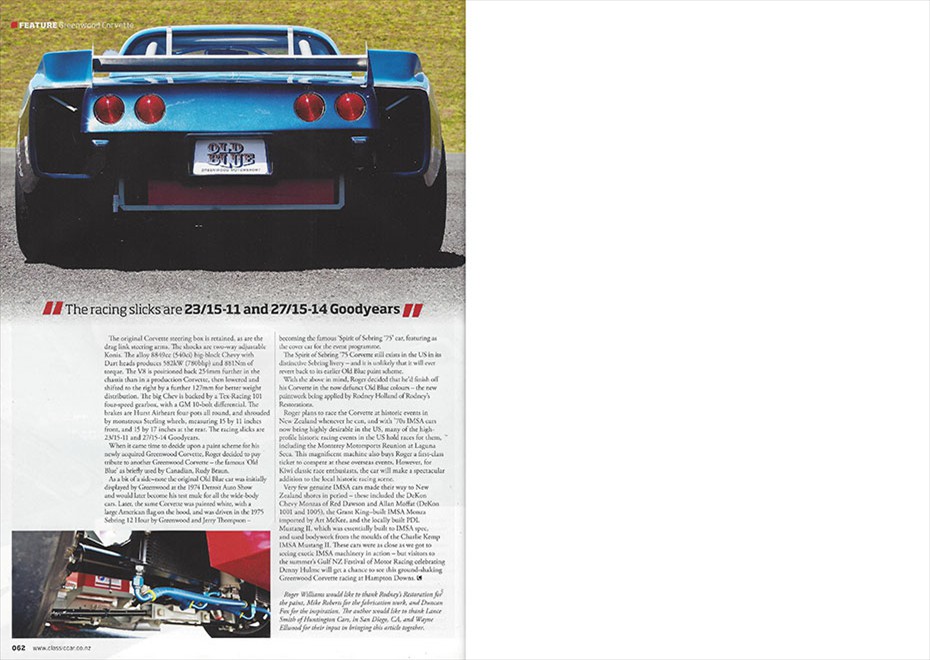RESTORATION AND FABRICATION
|
|
Before opening Medina Motorsports, back when I worked at Huntington Cars, I was responsible for much of the restoration of this incredible historic Corvette. These are a few of my photos of some of the steps in the process, plus a great magazine article about the history of the car.
|
All-American Express
Words Steve Holmes Photos Adam Croy
Steve looks at the history behind a historic racing Corvette that will appear at the Gulf Festival of Motor Racing celebrating Denny Hulme this summer.
By 1970, the Sports Car Club of America (SCCA) had the world at its feet. In the Trans-American Sedan Championship, the Canadian-American Challenge Cup, and the SCCA Grand Prix Championship, the SCCA had three championships that were globally recognized -- and the envy of virtually every racing group in the world.
Formed in 1944, for much of its early existence the SCCA catered mainly to amateur sports car enthusiasts -- part-time racers who held down nine-to-five jobs during the week but wanted to blow off a bit of steam on the weekends. Professional racing and the SCCA were very much at odds in those early years, and professional drivers as such were essentially banned from competing in SCCA events. However, by the early '60s the SCCA was beginning to split down the middle, with those wanting things to remain as they always were on one side, and those, led by John BIshop, who wanted to get involved in running professional championships, on the other. Bishop managed to convince enough of the SCCA directors that the could have both and that they could expand into professional road racing without affecting the amateur side of the club that it was build around.
The Trans-Am and Can-Am series were both introduced in 1966. Trans-Am effecitvely adopted the FIA's Group 1 and 2 rules, but with the additional criteria of a 5.0-litre engine limit and maximum 116-inch (2946mm) wheelbase, to prevent any liklihood of a bunch of circle-track stock car boys turning up and beating on the Lotus Cortinas and GTA Alfas in their 7.0-litre Galazies. Can-Am was also created around FIA rules, this time for big-bore Group 7 sports cars.
The following year, the SCCA completed the set by introducing the impressively titled Grand Prix Championship, an open-wheeler series split into three categories based on engine size -- Formula C and Formula B were both FIA categories (essentially Formula 3 and Formula 2), while Formula A was, effectively, Formula 1. After a decidedly average first season, in which only four cars contested Formula A, and Chuck Kirkbride won in an elderly Lotus, the SCCA announced new stock-block 5.0-litre rules for Formula A. Formula A, or Formula 5000 as it would become known elsewhere, quickly spread throughout the world, and would become the premier formula in both New Zealand and Australia within a few short years.
INTERNATIONAL MOTORSPORTS ASSOCIATION (IMSA)
So there they were, by 1970 the SCCA had Trans-Am, Can-Am, and Formula A all within its ranks, and massive manufacturer and constructor support. But it wasn't to last.
As far as Trans-Am was concerned, all the manufacturers left at the end of 1970, except American Motors. Then in 1972 Porsche combined with Penske Racing to finally topple McLaren's Can-Am stranglehold but, in doing so, far out-spent every other team in the history of the championship by a long way. With no other team prepared to match this massive over-spend, almost immediately everyone else gave up on the series and 1974 was the final year for Can-Am.
Formula A never gained teh national status the SCCA had hoped for and, following the 1976 season, it mad the questionable decision to try and rekindle the spirit of the old Can-Am series by demanding teams drape sports car bodies over their FA cars. The concept never really gained momentum, although the new generation Can-Am stumbled on until the early '80s before being quietly put to sleep. On top of all that, John Bishop -- the man responsible for much of the SCCA's success during the mid-to-late '60s -- quit in 1968 and went out on his own, eventually forming the International Motor Sports Association (IMSA).
Bishop became increasingly frustrated with continued resistance within the SCCA's ranks to keep their operations strictly amateur. He also disliked the attempts being made to tickle the Trans-Am rules and move them away from those set down by the FIA. So, when he formed IMSA he did so with the intention that it be a run-for-profit organisation that benefitted not just the IMSA hierarchy but also its teams. And he structured it around FIA Group 2 and 4 rules, so not only could teams purchase race-ready cars built to those rules, but European teams could enter the series, and not have to make changes to their cars in order to do so.
The early years of IMSA took on a strictly European flavour, with mostly Porsche and BMW dominance. Porsche had moved across from the Trans-Am, as, having dominated the 2.5 class the SCCA felt compelled to devise ways to reduce their advantage. Bishop was keen to gain manufacturer involvement, so in some respects the Porsche involvement was a triumph. But for race punters wanting to see local machinery take on the European exotics, IMSA left a little to be desired. Much of the US contingent was made up of amateur teams running old modified Trans-Am cars. Many teams were leaving the Trans-Am to run with IMSA, and try and scoop some of the lucrative prize money on offer, which amounted to nearly half a million dollars between major sponsors RJ Reynods, with their Camel Filters brand, and BF Goodrich tyres.
By the early '70s, the SCCA Trans-Am series was coming apart at the seams. American Motors remained until the end of 1972, but the factory race team was now being run by Roy Woods Racing, as Roger Penske felt he wasn't doing anyone any good by beating up on a bunch of privateers. For 1973, the SCCA went the way of IMSA, and adopted FIA Groups 2 and 4 rules, but these only allowed Porsche, which was dominant in its class, to now become an outright contender with the Carrera model. Its only real opposition were the Camaros and Corvettes, which were now allowed to run alloy big-block motors. The big Chevs had the legs on the Porsches, but were much thirstier than the little German machies and were constantly zapping in and out of the pits to refuel. Fortunately, the racing itself proved to be pretty entertaining, and Chevrolet won the manufacturer's championship.
However, for 1974 Porsche released its new RSR model, which was significantly faster than both the older Carrera and, perhaps more importantly, any of the V8s. It romped away to win all three (for this was what it had come down to) Trans-Am races. The RSR was also dominant in the nine-race IMSA championship. Indeed, IMSA had become such a force, with greater prize money, more races, and a greater desire to serve its competitors as best it could, that most simply treated the Trans-Am as a place to go race their IMSA cars on those weekends when there were no IMSA races.
For IMSA it wasn't such a great look -- an American series that was completely dominated by European machinery. Alas, no home-based manufacturer built a car that could go head-to-head with those offered by Porsche and BMW, so Bishop formulated an all-new class, one designed specifically at luring US manufacturers back into the sport. This class he named All-American GT.
JOHN GREENWOOD
Vince Piggins and John Pierce, both of General Motors, approached the SCCA about creating a special new class that would allow highly modified US machinery to take on the might of Porsche, but they were rejected. But when they approached Bishop with the same concept, they were met with a much more enthusiastic response. The new All-American GT (AAGT) rules allowed an American entrant to build a tube-frame ca from which they could hang the various mechanical components, and ontop of which they'd mount a body loosely representing a production vehicle.
General Motors teamed with Lee Dykstra and Horst Kweck of DeKon Engineering to build a series of tube-frame IMSA cars, with a heavily-modified Chevrolet Monza body attached. However, he presence of such AAGT cars in IMSA wasn't just limited to DeKon, for another team, that run by John Greenwood, was also fast making a name for itself, and, like DeKon, Greenwood also enjoyed some GM support.
John Greenwood was a former street racer from Detroit. His first road car, which he bought in 1960, was a 1955 Pontiac fitted with a 6899cc (421ci) NASCAR motor. He then graduated to Chevrolet Impalas, boring and stroking their 6702cc (409ci) motors out to 425ci (6964cc), before buying his first Corvette in 1964. He immediately ditched the car's 327 V8, replacing it with a new 427 big-block -- although this car only marked the beginning of constant experimentation.
That first Corvette saw more than a dozen different engines bolted into its engine bay at various times as Greenwood sought to evolve the car into the ultimate street racer. However, one day he took in a road racing event and, impressed by what he saw, naturally reckoned he could do better. Consequently, he enrolled in a road racing driving school with his street racer Corvette.
From completing that driving course, Greenwood gained a new-found respect for road racers and spent the next 12 months chasing his tail, trying to get a handle on the challenges involved. He eventually upgraded to a new 1968 Corvette and soon the results started to come. In 1969 he joined the SCCA, acquired his national race license and began competing in the A/Production sports car class. In 1970, Greenwood raced at both the Daytona 24 Hour and Sebring 12 Hour, and he won the SCCA A/Production Central Division championship and also won the 1970 SCCA A-Production National Title at the run-offs -- an annual event in which the top scoring teams from the various regions would all compete together at one event. This event also marked the first appearance of the 'Stars & Stripes' paint livery that would be forever linked with Greenwood's cars (there would be several variations on this theme throughout the next few years). In fact, it was John's brother, Burt, who created the distinctive paint scheme.
GREENWOOD'S ALL-AMERICAN GT
In 1971, Greenwood expanded to run a two-car Corvette team. The team would pull off multiple SCCA national wins and a first place in the International 12 Hour of Sebring Endurance Race. Greenwood also repeated his A-Production National Championship win at teh SCCA run-offs. In 1972, with backing from BF Goodrich, Greenwood ran another two-car team and also ran at the Le Mans 24 Hour race for the first time. In 1973, he ran a two-car effort at Le Mans again and, with teh SCCA restructuring its Trans-Am regulations to FIA Group 2 and 4, Greenwood was able to enter the Trans-Am series for the first time. Greenwood's cars took two victories from the sixround series and, after skipping the 1974 series, won three races and the Trans-Am Championship in 1975.
In 1974, Greenwood also released his new, radical 'wide-body' Corvette at the Detroit Auto Show -- a car intended for Trans-Am and IMSA competition. This new, clean-cut machine looked absolutely massive with slab-sided flares that ran down each flank, ending in an integral rear spoiler. Zora Arkus-Duntov, creator of the Corvette, played a pivotal role in the design of the new bodywork, as he took a close interest in the Greenwood cars, and arranged for the GM styling department to pen the new lines. Greenwood's team then dropped the body over the frame to further lower it, and dipped the nose even closer to the ground to gain more rake for added downforce. Suspension was coil-spring -- although his cars sometimes ran a token transverse leaf when the rules required they retain the original suspension layout. The big-block alloy Chevrolet V8s were fitted with Greenwood corss-ram Lucas fuel-injection systems and pumped out 522kW (700bhp) which, for 1974, was impressive.
The Greenwood Corvettes continued to be developed throughout the '70s, until a pair of Bob Riley- designed tube-frame cars were constructed in 1977 -- the first Greenwood Corvettes that didn't retain the original frame. In amongst it all, inspired by the race cars, Greenwood also developed his own Corvette road cars.
TRIBUTE TO OLD BLUE
With Greenwood Corvettes doing so well, customers began rolling up, all wanting their own versions. Several customer cars were built throughout the '70s for privateer teams to contest IMSA and Trans-Am. One of these is the car now owned by Kiwi historic racing enthusiast, Roger Williams, and was only recently imported into New Zealand. This car started life around 1977 as an earlier 1968-'69 base Greenwood-built L88, with the much milder FIA-style flares of the pre-1974 Greenwood cars. In February 1979, it was purchased by amateur racer Bill 'Snoopy' Wessel, who raced it twice that year, both times at Daytona, including the November Daytona Finale 250 Mile event. At some point the car was upgraded to wide-body specifications. Of the 12 wide-body Greenwood cars, Roger's car is number 005.
After its 1979 races, the Corvette was then parked up and sat for many years before Greenwood historian, Lance Smith, tracked it down in 1992. He was eventually able to purchase the car from Wessel in 2005. Smith then treated it to a stunning restoration, back to wide-body guise.
This Corvette features anti-squat rear suspension, with fabricated hub-carriers, and adjustable lower arms. The front suspension is modified with spherical joint-mounted lower control arms, Corvette front spindles and Greenwood bump-steer control blocks. The rear suspension, like the roll-cage, was designed by Bob Riley, an engineer with mechanical and aeronautical degrees who worked at, among other places, Chryster's Space Division, and helped build the Saturn space rocket that took Neil Armstrong to the moon. He also worked at Kar-Kraft on the GT40 project, and for AJ Foyt. He designed the two tube-frame Greenwood Corvettes in 1977.
The original Corvette steering box is retained, as are the drag link steering arms. The shocks are two-way adjustable Konis. The alloy 8849cc (540ci) big-block Chevy with Darr heads produces 582kW (780bhp) and 881Nm of torque. The Vd is positioned back 254mm further in the chassis than in a production Corvette, then lowered and shifted to the right by a further 127mm for better weight distribution. The big Chev is backed by a Tex-Racing 101 four-speed gearbox, with a GM 10-bolt differential. The brakes are Hurst Airheart four-pots all around, and shrouded by monstrous Sterling wheels, measuring 15 by 11 inches front, and 15 by 17 inches at the rear. The racing slicks are 23/15-11 and 27/15-1 Goodyears.
When it came time to decide upon a paint scheme for his newly acquired Greenwood Corvette, Roger decided to pay tribute to another Greenwood Corvette -- the famous 'Old Blue' as briefly used by Canadian, Rudy Braun.
As a bit of a side-note the original Old Blue car was initially displayed by Greenwood at the 1974 Detroit Auto Show and would later become his test mule for all the wide-body cars. Later, the same Corvette was painted white, with a large American flag on the hood, and was driven in the 1975 Sebring 12 Hour by Greenwood and Jerry Thompson -- becoming the famous 'Spirit of Sebring '75' car, featuring as the cover car for the event programme.
The Spirit of Sebring '75 Corvette still exists in the US in its distinctive Sebring livery -- and it is unlikely that it will ever revert back to its earlier Old Blue paint scheme.
With the above in mind, Roger decided that he'd finish off his Corvette in the now defunct Old Blue colours -- the new paintwork being applied by Rodney Holland of Rodney's Restorations.
Roger plans to race the Corvette at historic events in New Zealand whenever he can, and with '70s IMSA cars now being highly desirable in the US, many of the high-profile historic racing events in the US hold races for them, including the Monterey Motorsports Reunion at Laguna Seca. This magnificent machine also buys Roger a first-clas ticket to compete at these overseas events. However, for Kiwi classic race enthusiasts, the car will make a spectacular addition to the local historic racing scene.
Very few genuine IMSA cars made their way to New Zealand shores in period -- these included the DeKon Chevy Monzas of Red Dawson and Allan Moffat (DeKon 1001 and 1005). the Grant King-built IMSA Monza imported by Art McKee, and the locally built to IMSA spec, IMSA Mustang II. These cars were as close as we got to seeing exotic IMSA machinery in action -- but visitors to the summer's Gulf NZ Festival of Motor Racing celebrating Denny Hulme will get a chance to see this ground-shaking Greenwood Corvette racing at Hampton Downs.
Roger Williams would like to thank Rodney's Restorations for the paint, Mike Roberts for the fabrication work, and Duncan Fox for the inspiration. The author would like to thank Lance Smith of Huntington Cars, in San Diego, CA, and Wayne Ellwood for their input in bringing this article together.
HOME | TRACK SUPPORT | ADDITIONAL SUPPORT | PREPARATION | TRANSPORT | RESTORATION | CORPORATE SUPPORT
ALEX MOTOLA | TONY HART |TRACE CHALMERS | MICHAEL MARTIN


